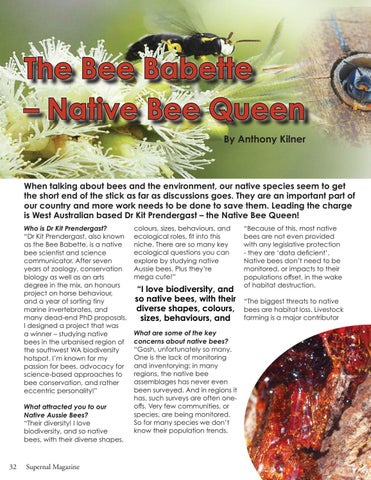The Bee Babette – Native Bee Queen By Anthony Kilner
When talking about bees and the environment, our native species seem to get the short end of the stick as far as discussions goes. They are an important part of our country and more work needs to be done to save them. Leading the charge is West Australian based Dr Kit Prendergast – the Native Bee Queen! Who is Dr Kit Prendergast? “Dr Kit Prendergast, also known as the Bee Babette, is a native bee scientist and science communicator. After seven years of zoology, conservation biology as well as an arts degree in the mix, an honours project on horse behaviour, and a year of sorting tiny marine invertebrates, and many dead-end PhD proposals, I designed a project that was a winner – studying native bees in the urbanised region of the southwest WA biodiversity hotspot. I’m known for my passion for bees, advocacy for science-based approaches to bee conservation, and rather eccentric personality!” What attracted you to our Native Aussie Bees? “Their diversity! I love biodiversity, and so native bees, with their diverse shapes,
32 32
Supernal Magazine
colours, sizes, behaviours, and ecological roles, fit into this niche. There are so many key ecological questions you can explore by studying native Aussie bees. Plus they’re mega cute!”
“I love biodiversity, and so native bees, with their diverse shapes, colours, sizes, behaviours, and What are some of the key concerns about native bees? “Gosh, unfortunately so many. One is the lack of monitoring and inventorying: in many regions, the native bee assemblages has never even been surveyed. And in regions it has, such surveys are often oneoffs. Very few communities, or species, are being monitored. So for many species we don’t know their population trends.
“Because of this, most native bees are not even provided with any legislative protection - they are ‘data deficient’. Native bees don’t need to be monitored, or impacts to their populations offset, in the wake of habitat destruction. “The biggest threats to native bees are habitat loss. Livestock farming is a major contributor
